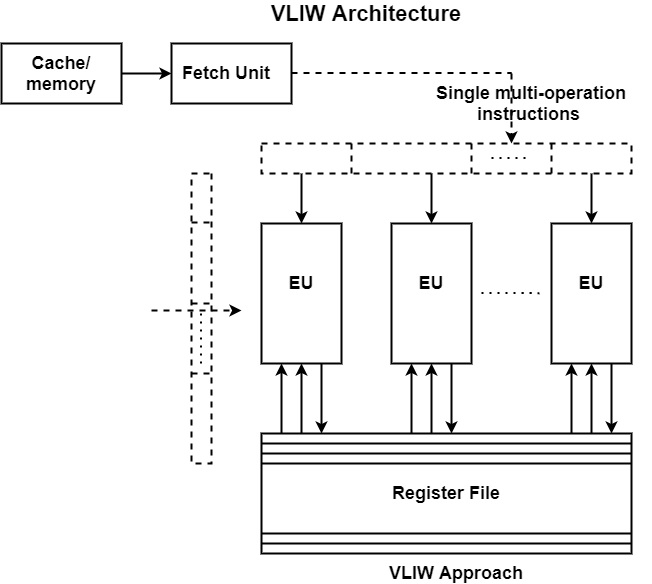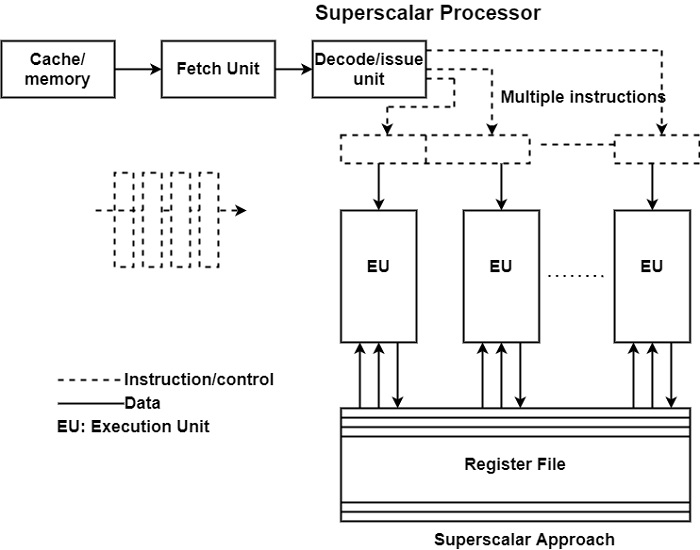
 Data Structure
Data Structure Networking
Networking RDBMS
RDBMS Operating System
Operating System Java
Java MS Excel
MS Excel iOS
iOS HTML
HTML CSS
CSS Android
Android Python
Python C Programming
C Programming C++
C++ C#
C# MongoDB
MongoDB MySQL
MySQL Javascript
Javascript PHP
PHP
- Selected Reading
- UPSC IAS Exams Notes
- Developer's Best Practices
- Questions and Answers
- Effective Resume Writing
- HR Interview Questions
- Computer Glossary
- Who is Who
What is the difference between VLIW architecture and Superscalar processor?
VLIW Architecture
VLIW represents a Very long instruction word. It is an instruction set architecture constructed to take complete benefit of instruction-level parallelism (ILP) for upgraded performance.
Central processing unit processors enable programs to designate instructions to execute in order only whereas a VLIW processor enables programs to explicitly determine instructions to implement in parallel. This design is designed to enable higher implementation without the complexity inherent in some different designs.
VLIW architectures are closely associated with superscalar processors. Both objectives at speeding up computation with the aid of exploiting instruction-level parallelism. Both have almost a similar execution basis, including various execution units (EUs) controlling in parallel, and employing either a unified register file for all data types or specific (split) register files for FX and FP data, as shown in the figure.

Superscalar Processor
A superscalar processor is invented to produce an execution cost of higher than one instruction per clock cycle for an individual sequential program. Superscalar processor design defines a set of approaches that enable the central processing unit (CPU) of a computer to obtain a throughput of higher than one instruction per cycle while implementing an individual sequential program.
A superscalar architecture consists of parallel execution units, which can execute instructions at the same time. This parallel architecture was first executed in RISC processors, which use brief and simple instructions to implement computation. Because of their superscalar efficiency, RISC processors have normally performed higher than CISC processors running at the equal megahertz.
The main function of superscalar processing is the superscalar instruction issue. A higher issue rate provides rise to higher processor execution, simultaneously, it intensifies the restrictive result of control and data dependencies on the processor implementation as well.

Let us see the comparison between VLIW Architecture and Superscalar Processor.
| VLIW Architecture | Superscalar Processor |
|---|---|
| VLIW Architecture receives single multi-operation instruction. |
Superscalar processor except for a traditional sequential flow of instruction but it can issue multiple instructions. |
| VLIW approach needs very long instruction words to specify what each execution unit should do. |
The superscalar processor receives sequential streams then it is decoded and the issues unit will issue multiple instructions for multiple execution units. In superscalar, the instruction unit can issue 2 to 6 instructions per cycle. |
| VLIW architecture processors expect dependency-free code. |
Superscalar processors do not expect dependency-free code to deal with dependencies using special hardware. |
| VLIW is less complex. |
Superscalar processors with the same degree of parallelism are more complex than VLIW architecture. |
| VLIW is used for static scheduling. |
Superscalar is used for dynamic scheduling. |

